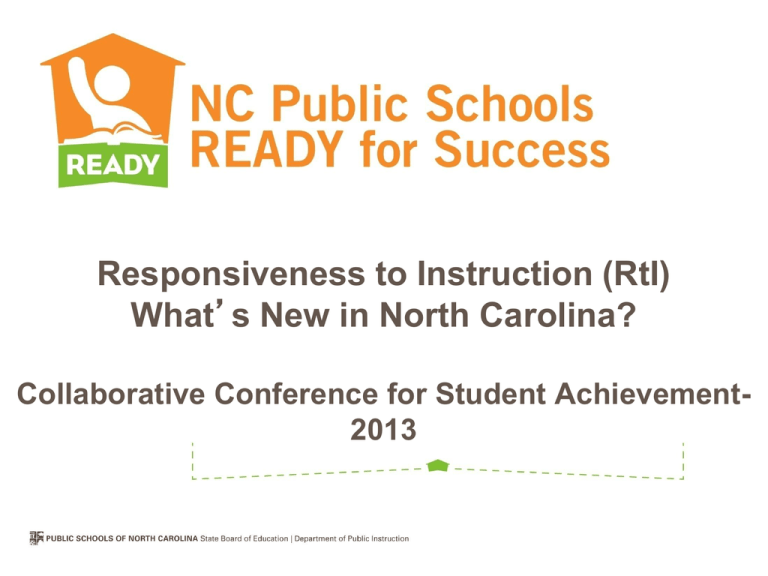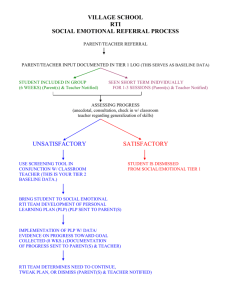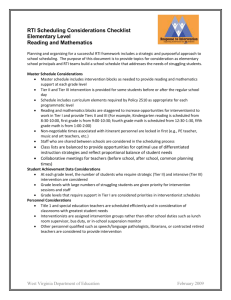Responsiveness to Instruction (RtI) What Collaborative Conference for Student Achievement-
advertisement

Responsiveness to Instruction (RtI) What’s New in North Carolina? Collaborative Conference for Student Achievement2013 Objectives • Become familiar with the current work of NCDPI regarding Responsiveness to Instruction (RtI) • Know the key differences between the four and three tier RtI model • Identify the critical components of RtI as a framework for school improvement RtI State Leadership Team Angela Quick, Deputy Chief Academic Officer Maria Pitre-Martin, Director, K-12 Curriculum and Instruction – Ivanna Mann Thrower, ESL/ Title III Consultant – Cynthia Dewey, ELC Education Consultant, Region 5, Office of Early Learning (PK- Grade 3) Mary Watson, Director, Exceptional Children – Sherry Thomas, Assistant Director, Exceptional Children – Lynne Loeser, SLD/ ADHD Consultant, Exceptional Children Allison Whitaker, Consultant, Federal Program Monitoring and Support Rick PowersStatewide RtI Building Administrator Consultant History of RtI in NC 5 North Carolina Problem-Solving Model • 2000 Study began • 2004 Five pilot sites • 2006 State wide training • 2008 Regional training & trainers • 2010 General education partnership • 2011 Implementation Science • 2012 Transition to RtI three tier model NC DPI Definition of RtI NC Responsiveness to Instruction (NCRtI) is a multi-tiered framework which promotes school improvement through engaging, high quality instruction. NCRtI employs a team approach to guide educational practices, using a problem-solving model based on data, to address student needs and maximize growth for all. 7 Critical Components of RtI • Leadership and Shared Responsibility • Curriculum and Instruction • Assessment • Problem-Solving/Data-Based Decision Making • Family and Community Partnerships • Sustainability and Integration 8 Current State Work • Scaling Up Work Group – Focused work with State Implementation and Scaling up of Evidence-based Practices (SISEP) – Collaboration across DPI Agency and Institutions of Higher Education, and LEA representation • Collaboration with RtI and PBIS – Developing one Multi-tiered System of Support • Secondary RtI Pilots- Oak Foundation Grant Transitioning from Four to Three Tier Model Adjusting Mindsets Process for some students Framework for total school improvement Why Shift? • Place focus on problem-solving foundational core for total school improvement • Increase focus on general education • Movement away from viewing RtI as a process to a framework for all students • Integrate with Positive Behavior Intervention and Support (PBIS) Special Education Title I Slide created by Dale Cusumano, Ph.D. AIG ESL 13 Special Education Title I AIG ESL Educating Collaboratively Slide adapted from Dale Cusumano, Ph.D. 14 System of Support for Student Success Problem-Solving Model Four Tier RtI Model Evidence-Based Practices Data-Based Decision Making Three Tier RtI Model Perceived focus on individual students Individual student data only Monitor all students’ response 7 Step ProblemSolving TIPS Four Tiers Three Tiers Individual paperwork at all Tiers Education in silos Focus on Core instruction at all tiers Core Paperwork at Tier I Perceived as route to Special Ed All students in Tier I Shared Education What Happened? 17 Defining, Analyzing and Monitoring Tiers I, II and III Layering of Support Intensive Support Supplemental Support Differentiated Core 19 Foundational Core: Tier 1 Who: All students are in Tier 1 (Foundational Core) What: Evidence-based programs and practices demonstrated to produce good outcomes for the majority of students Effectiveness: If at least 80% of all students are meeting benchmarks in Foundational Core alone. What about subgroups? 20 Foundational Core: Tier 1 • Includes all students • Focus on all students across a grade and response to foundational core • Document on one grade level problem-solving form • Monitor response (of all students) to instructional changes Foundational Core: Tier 1 • Enhanced core • Increased academic engaged time • Less paperwork • Less progress monitoring Analyzing Foundational Core Analyzing Foundational Core • Are at least 80% of your students proficient in each subgroup with foundational core alone? • What is working? Why? How do you know? • What’s not working? Why? How do you know? • Do teachers have needed skills & content knowledge? Supplemental Instruction: Tier II Who: Students needing supplemental support in addition to Foundational Core instruction (approx. 20% of students) What: Evidence-based programs and practices demonstrated to improve performance in Foundational Core Effectiveness: If at least 70-80% of students improve performance toward Foundational Core standards Slide adapted from G. Batsche Supplemental Instruction: Tier II • Instruction is connected to core content • Supplemental instruction does not supplant core • Documentation is on same form for individual student • Analysis of effectiveness of Tier II instruction for all students toward Foundational Core standards Intensive Instruction: Tier III Who: Students needing Intensive support in addition to Supplemental and Foundational Core instruction (approx. 5% of students) What: Evidence-based programs and practices demonstrated to improve performance Effectiveness: If there is progress toward performance in Foundational Core standards Slide adapted from G. Batsche 27 Intensive Instruction: Tier III • Instruction is most intensive in the building • Increase intensity and frequency (time, duration, or digging deeper in specific skill) • Documentation is on same form for individual student • Analysis of effectiveness of Tier III instruction for all students toward Foundational Core Standards Training, Support and Information Training Spring 2013 Transition 4 to 3 Tier Training Module 1- LEA Hosted February 7-8 Elizabeth City March 20-21 Raeford April 10-11 Thomasville April 17-18 Asheville TBA by LEA Summer 2013 Module 1 Dates and Locations TBA Training, Support and Information • Ongoing Technical Assistance to District Teams through RtI Field Consultants • Regional Networking Meetings– Conducted every other month in each region • Listserv – Email your regional field consultant Contact Information for Training and Support • Anne Nixon- Regions 1, 2, 3 annednixon@gmail.com • Amy Miller- Regions 3, 4, 5 amym717@gmail.com • Amy Jablonski- Regions 6, 7, 8 amy.jablonski@gmail.com • Rick Powers- Statewide Consultant rick.powers@dpi.nc.gov Questions Wisdom from the Field- Panel Discussion


